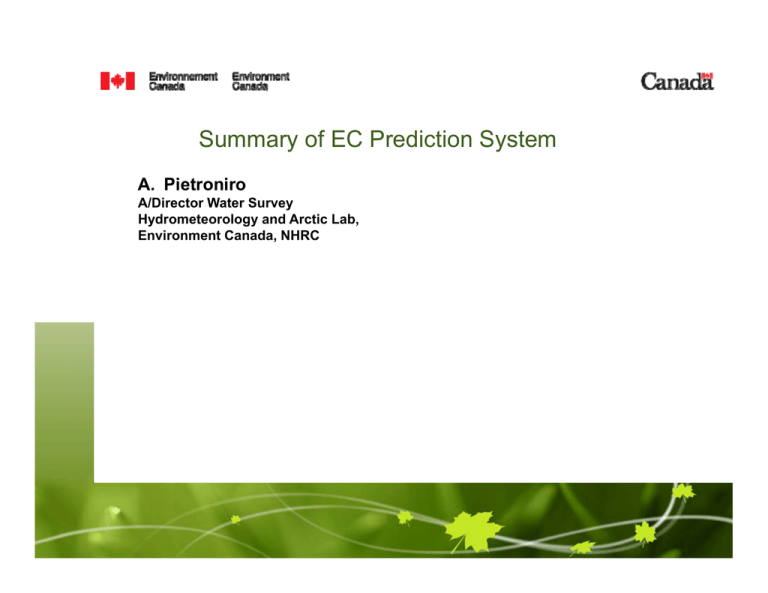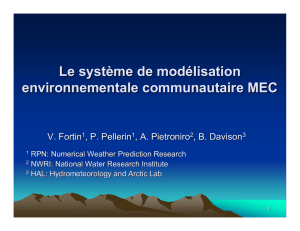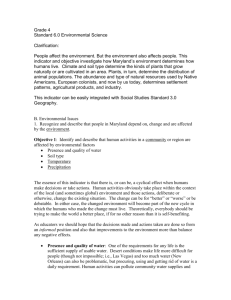Summary of EC Prediction System A Pietroniro A. Pietroniro A/Director Water Survey
advertisement

Summary of EC Prediction System A Pietroniro A. A/Director Water Survey Hydrometeorology and Arctic Lab, Environment Canada, NHRC Monitoring, Prediction and Forecasting • Hydrological y g p processes are highly g y variable in space p and time at all scales from centimeters to continents. – Data collection over such a range is difficult and expensive – Hydrological y g p prediction fills the g gap p ▪ ▪ ▪ ▪ Based on simple and homogenous models of nature Range from deterministic to statistical/stochastic methods Results are fair to good in well behaved basins Scaling, pathways, dynamics, energy balance … still to be resolved • Significant advances are still made through observations – Environment Canada – Schisms between data collection and hydrological science – In the excitement of “glamorous science” the scientific community often ft lets l t data d t collection ll ti programs erode d – All models are wrong some are useful S P A C E S C A L E Global Environmental Multiscale Forecasting & Modeling System 2002-2007 Middle Atmosphere Model & Data assimilation Multi- Seasonal Forecast Monthly Forecast Medium-range Forecast ( 240 h 35-100 km ) & Data assimilation Regional and Mesoscale Forecast ( 24-48 24 48 h 10 10-24 24 kkm ) & Data assimilation Ensemble Forecast Regional Climate Model LAM 0-24h 1-4km TIME SCALE supercomputer (2003): 800 processors (IBM Power4) Uniform resolution V i bl resolution Variable l i Hydrostatic Nonhydrostatic Global Limited-area Distributed memory --------------------------------3D Var Data Assimilation 4D Var Data Assimilation Operational p forecast Emergency response Volcanic ashes Air quality Stratospheric ozone Wave model Coupling to Hydrology Coupling to Oceanology Simulations etc Improved Soil Water Balance CLASS 2.7 Model Surface Excess θ1 WatCLASS (class3.0) θ1 θ2 θ2 θ3 θ3 Drainage g Drainage a age MESH: A MEC surface/hydrology configuration designed for regional hydrological modeling • The tile connector (1D, scalable) redistributes mass and energy between tiles in a grid cell Tile connector – e.g. snow drift • The grid connector (2D) is responsible for routing runoff – can still be parallelized by grouping grid cells by subwatershed Grid connector Hydrological Prediction Framework Upper air observations 4DVar Precipitation (forecasted) E Evapotranspiration t i ti Snow water equivalent Soil moisture GEM atmospheric model with ISBA land surface scheme Hydrological y g model with its own LSS (e.g. WATFLOOD) Surface observations Precipitation (interpolated) Evapotranspiration Snow water equivalent Soil moisture Streamflow Who do you believe? Environmental Prediction Framework Upper air observations 4DVar data assimilation CaPA: Canadian precipitation p p analysis Surface observations CaLDAS: C LDAS Canadian land data assimilation ass at o GEM atmospheric model “On-line” mode “Off-line” mode Surface scheme ((CLASS or ISBA)) and routing model MESH Modélisation environnementale communautaire (MEC) de la surface et de l’hydrologie Spatially and physically coherent estimates of: - Precipitation - Evapotranspiration E i i - Snow water equivalent - Soil moisture - Streamflow Community Model • MEC is available for download: – As the current version of MEC is a subset of the GEM atmospheric model driver, go to: http://collaboration.cmc.ec.gc.ca/science/rpn.com/ – Then Click on « GEM » – Complete documentation for installing and running MEC available online Precipitation analysis (CaPA) • Combine different sources of information on precipitation into a single, near real-time analysis y – Analysis of 6h accumulation of precipitation, covering all of North America on a 15km grid – Optimal interpolation technique to obtain our best estimate of precipitation Atmospheric model Surface network Satellite observations RADAR Land data assimilation (CaLDAS) • • Biases in energy and water storage can develop in coupled modeling systems due to incorrect representation of physical processes, atmospheric forcing, and surface characteristics. Land Data Assimilation Systems (LDAS) driven by observations and constrained by data assimilation have potential to more accurately depict land surface conditions ATMOSPHERIC FORCING T, hu, winds Precipitation (CaPA) Radiation LAND SURFACE DATABASES Off-Line land surface models OBSERVATIONS Vegetation Snow Soil moisture Surface and soil temp • Space-based remote sensing • Screen-level met obs • in-situ i it surface f measurements t • Transfer models required The Canadian EPS Starting January 2006: • 15 day runs twice per day • 10 perturbed runs from each model • Surface scheme: – 10 members with F-R – 10 members with ISBA Collaborative Studies • Research – MESH testing – – – – – Canada DRI – Drought Research Initiative IP3 – Process p parameterization and Predictions – IPY Great Lakes Ensemble Modelling Climate Change Assessments – SSRB IPY IP3 DRI GLEI Map created by Jackie Bronson Glacier contribution to flow – IP3 South Saskatchewan basin North Saskatchewan basin Mistaya River M onthlyF low(C M S ) 25 20 15 10 5 0 8/1/80 12/1/83 Time (month) 8/1/90 Siffleur River 40 M onthlyF low(C M S ) 4/1/87 30 20 10 0 8/1/80 12/1/83 Time (month) 8/1/90 Ram River 100 M onthlyF low(C M S ) 4/1/87 80 60 40 20 0 8/1/80 1998 extent 12/1/83 Time (month) 1975 Extent 4/1/87 8/1/90 None Pipestone River M onthlyFlow(C M S) 30 20 10 0 8/1/80 12/1/83 M onthlyFlow(C M S) 50 Time (month) 4/1/87 8/1/90 Bow River at L. Louise 40 30 20 10 0 8/1/80 12/1/83 M onthlyFlow(C M S) 160 Time (month) 4/1/87 8/1/90 Bow River at Banff 120 80 40 0 8/1/80 12/1/83 Time (month) 4/1/87 8/1/90 The HEPEX Canada EPS Multi-model ensemble (SEF + GEM) • T149 for SEF, 1.2º for GEM • A different parameterization is used for each member Since June 2001: • 10 day runs once a day • 8 perturbed t b d runs ffrom each h model • Surface scheme: – force-restore Starting January 2006: • 15 day runs twice per day • 10 perturbed t b d runs ffrom each h model • Surface scheme: – 10 members with F-R – 10 members with ISBA Forecasting DRI/NAESI / S •MESH development •CaPA development •CaLDAS development •Assess the validity of MESH, CaPA and CaLDAS products •Technology transfer Two nested modelling domains SSRB xOrigin g yOrigin xCount yCount xDelta yDelta -117.0000 48.0000 60 27 0.2º 0 2º 0.2º Brightwater Creek g -106.6836 xOrigin yOrigin 51.199 xCount 54 yCount 52 xDelta 800 m yDelta 800 m Stand alone MESH • MESH model physics (CLASS LSS) – • Forcing with met tower data – • Soil Temperature - Layer 1 - Kenaston area Flux Tower site ( °C) 35 30 with added routing based on Watroute Temp, precip, station pressure, specific humidty, wind, lw and sw radiation May y 15 to November, 2007, half hourly y Soil Moisture - Kenaston area - Flux tower site [Fraction] 0.45 0.4 SIM OBS [5cm] 25 20 0.35 0.3 0.25 15 0.2 10 0.15 5 0.1 0 0.05 -5 15-May-07 15-Jun-07 15-Jul-07 15-Aug-07 15-Sep-07 15-Oct-07 SIM OBS [5cm] 0 15-May-07 15-Jun-07 15-Jul-07 15-Aug-07 15-Sep-07 15-Oct-07 Summary and future considerations • Stand alone MESH demonstrates that it is possible to reasonably replicate some water • • availability parameters. CaPa show some benefits to precipitation re-analysis. Will be operation this year. A first version of CalDAS has been tested with ISBA. – Future versions will ▪ Assimilate soil moisture directly (if avaialbel) ▪ Will be based on CLASS MEC system is moving towards the same internal representation of the behavior of the standalone MESH and has the added benefit of the use of land surface data assimilation • The goal is to provide calibration and verification from MEC and MESH and evaluate the system in an operation mode. – – Further evaluation over the next 2 years. years Parameterizations and other changes to stand-alone MESH will be incorporated into the operational model. • 10 Day forecasts – – – MEC/MESH can already provide 10 forecasts using deterministic and ensembles forecasts All water vaiability indicators could be forecasted Could be very useful for irrigation scheduling – MEC/MESH will be incorporated into the Canadian Forecasting system – – Force MESH standalone with RCM output Run MEC in Climate Mode • Seasonal Forecast • Climate change








